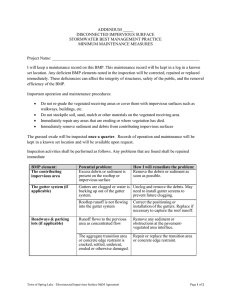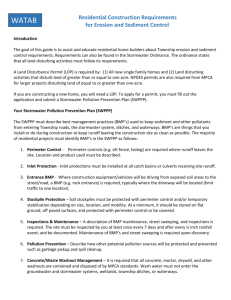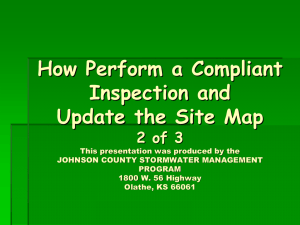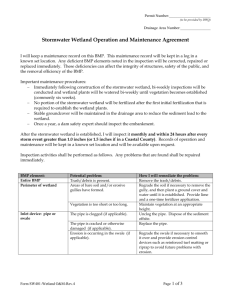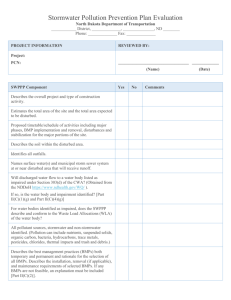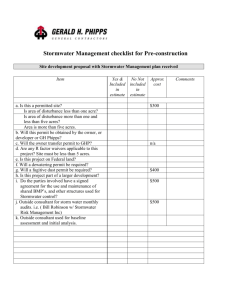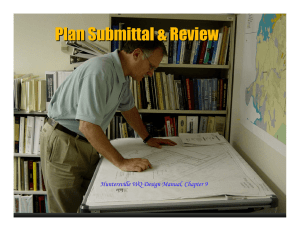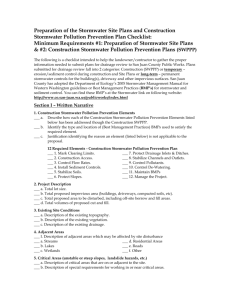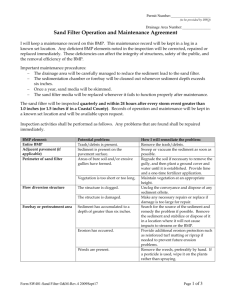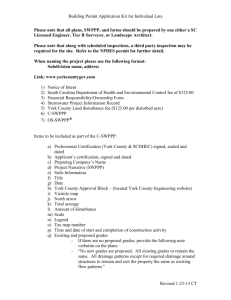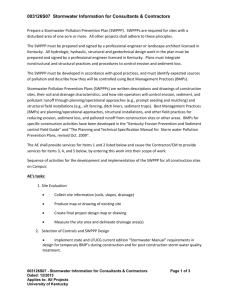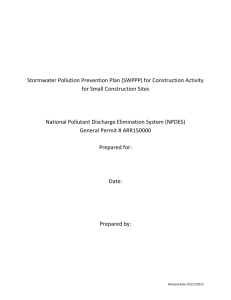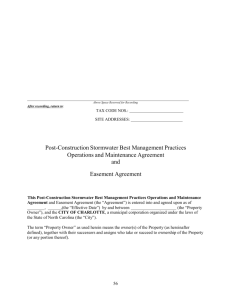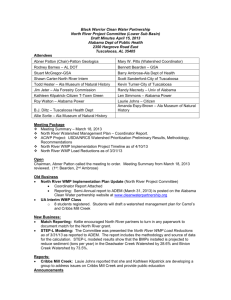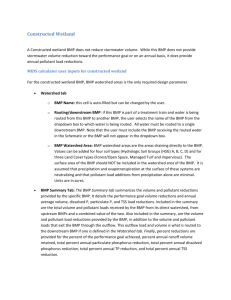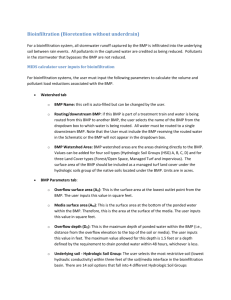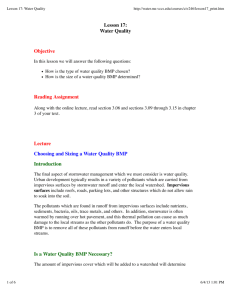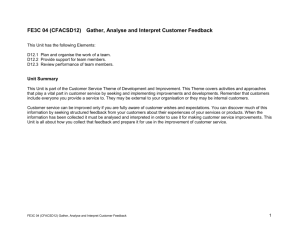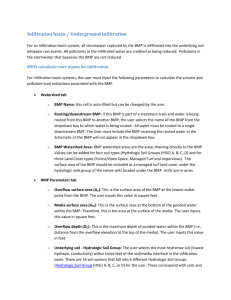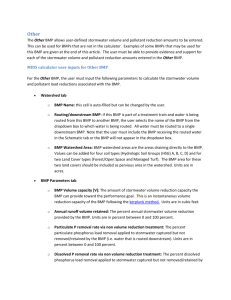Land Disturbance Permit Review Checklist
advertisement
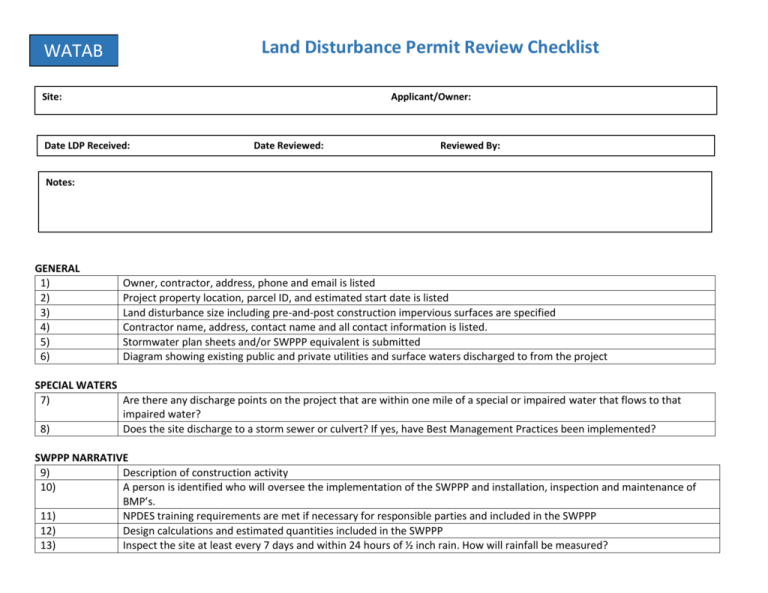
Land Disturbance Permit Review Checklist WATAB Site: Applicant/Owner: Date LDP Received: Date Reviewed: Reviewed By: Notes: GENERAL 1) 2) 3) 4) 5) 6) Owner, contractor, address, phone and email is listed Project property location, parcel ID, and estimated start date is listed Land disturbance size including pre-and-post construction impervious surfaces are specified Contractor name, address, contact name and all contact information is listed. Stormwater plan sheets and/or SWPPP equivalent is submitted Diagram showing existing public and private utilities and surface waters discharged to from the project SPECIAL WATERS 7) Are there any discharge points on the project that are within one mile of a special or impaired water that flows to that impaired water? 8) Does the site discharge to a storm sewer or culvert? If yes, have Best Management Practices been implemented? SWPPP NARRATIVE 9) Description of construction activity 10) A person is identified who will oversee the implementation of the SWPPP and installation, inspection and maintenance of BMP’s. 11) NPDES training requirements are met if necessary for responsible parties and included in the SWPPP 12) Design calculations and estimated quantities included in the SWPPP 13) Inspect the site at least every 7 days and within 24 hours of ½ inch rain. How will rainfall be measured? 14) 15) 16) 17) PLAN SHEETS 18) 19) 20) 21) 22) 23) 24) Installation and timing for all BMP’s as described All final stabilization methods are described for all exposed soils Clean out sediment from conveyances and sediment basins (return to capacity) SWPPP must account for expected precipitation, expected stormwater run-on and run-off and range of soil sizes for BMP design factors Site map with existing and final grades and direction of flow for all pre-and-post construction drainage. Map also includes impervious surfaces, soil types, and topology Areas not to be disturbed clearly defined including proper buffers and phasing All surface waters and existing culverts and storm sewers which will receive stormwater runoff during or after construction are identified BMP’s are identified Procedures to establish additional temporary BMP’s Methods used to minimize soil compaction and preserve topsoil described Are temporary sediment basins required for the site? PERMANENT STORMWATER TREATMENT 25) Are MPCA water quantity, quality, rate and BMP design requirements met as reviewed by the township? 26) Long term maintenance plan and responsible party are submitted for all permanent stormwater BMP’s EROSION PREVENTION 27) Stabilization initiated immediately when activity will be ceased for 14 days. All exposed soil areas must be stabilized no later than 14 days after activity has ceased. Protections described? 28) Last 200 feet of drainage ditch is stabilized with 24 hours after connection to a surface water. Practices described? 29) Pipe outlets have energy dissipation within 24 hours 30) Unless infeasible, must direct discharges from BMP’s to vegetated areas of the site SEDIMENT CONTROL 31) Sediment control practices are established on down gradient perimeters (i.e. silt fence, biologs, etc) 32) Are all inlets properly protected? 33) Do stockpiles have sediment controls, and are they placed in areas away from surface waters? 34) Are all construction site entrances/exits identified and do they have appropriate BMP’s? (i.e. rock entrance) 35) Is a street sweeping plan identified? 36) Is project within 50 feet of surface water? Is there a 50’ buffer or sediment control BMP’s to protect surface water? 37) Is sediment control plan appropriate for site conditions? POLLUTION PREVENTION AND OTHER BMP’S 38) Is there a plan in place for dewatering as to not cause nuisance conditions, erosion, and utilize sediment basins? 39) Pesticides, herbicides, fertilizers, treatment chemicals, etc. must all be under cover. 40) Hazardous materials (oil, gas, paint, etc) must be property stored in sealed containers and meet State secondary containment requirements 41) Solid wastes are stored, collected, and disposed of properly 42) Portable toilets are secured 43) Adequate spill response kit and disposal plan are available on site. Spills must be cleaned up immediately 44) All MPCA liquid and solid waste (concrete, stucco, paint, cures, etc) washout requirements are met? (wash water must not touch the ground)
